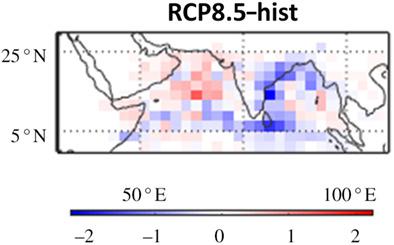当前位置:
X-MOL 学术
›
Int. J. Climatol.
›
论文详情
Our official English website, www.x-mol.net, welcomes your
feedback! (Note: you will need to create a separate account there.)
North Indian Ocean tropical cyclone activity in CMIP5 experiments: Future projections using a model‐independent detection and tracking scheme
International Journal of Climatology ( IF 3.5 ) Pub Date : 2020-04-07 , DOI: 10.1002/joc.6594 Samuel S. Bell 1 , Savin S. Chand 1 , Kevin J. Tory 2 , Hua Ye 2 , Chris Turville 1
International Journal of Climatology ( IF 3.5 ) Pub Date : 2020-04-07 , DOI: 10.1002/joc.6594 Samuel S. Bell 1 , Savin S. Chand 1 , Kevin J. Tory 2 , Hua Ye 2 , Chris Turville 1
Affiliation

|
The sensitivity of tropical cyclone (TC) projection results to different models and the detection and tracking scheme used is well established. In this study, future climate projections of TC activity in the North Indian Ocean (NIO) are assessed with a model‐ and basin‐independent detection and tracking scheme. The scheme is applied to selected models from the coupled model intercomparison project phase 5 (CMIP5) experiments forced under the historical and representative concentration pathway 8.5 (RCP8.5) conditions. Most models underestimated the frequency of early season (April–June) TCs and contained genesis biases equatorward of ~7.5°N in comparison to the historical records. TC tracks detected in reanalysis and model data were input to a clustering algorithm simultaneously, with two clusters in the Arabian Sea and two in the Bay of Bengal (k = 4). Projection results indicated a slight decrease of overall TC genesis frequency in the NIO, with an increase of TC genesis frequency in the Arabian Sea (30–64%) and a decrease in the Bay of Bengal (22–43%), consistent between clusters in each of these sub‐regions. These changes were largely due to changes in the pre‐monsoon season (April–June) where Bay of Bengal TCs significantly decreased, consistent with changes in vertical ascent. Northern Arabian Sea TCs significantly increased during the pre‐monsoon season, consistent with changes in vertical wind shear and relative humidity. There was a projected increase of TC frequency in the post‐monsoon season (October–December), consistent with changes in relative humidity and vertical ascent, although not all clusters followed this trend; noting a different response in the southern Bay of Bengal. In turn, these projections caused changes to the climate averaged TC track density, including a decrease (up to 2 TCs per decade) affecting the eastern coast of India and a small increase (up to 0.5 TCs per decade) affecting eastern Africa, Oman and Yemen.
中文翻译:

CMIP5实验中的北印度洋热带气旋活动:使用与模型无关的检测和跟踪方案的未来预测
热带气旋(TC)投影结果对不同模型的敏感性以及已建立的探测和跟踪方案都已建立。在这项研究中,北印度洋(NIO)TC活动的未来气候预测是通过独立于模型和盆地的探测和跟踪方案进行评估的。该方案适用于在历史和代表性浓度路径8.5(RCP8.5)条件下强制进行的耦合模型比对项目第5阶段(CMIP5)实验中选择的模型。与历史记录相比,大多数模型都低估了早期(4月至6月)TC的频率,并且其成因偏向赤道约为7.5°N。重新分析中检测到的TC轨迹和模型数据被同时输入到聚类算法中,其中两个在阿拉伯海中,两个在孟加拉湾中(ķ= 4)。投影结果表明,NIO的总体TC发生频率略有下降,阿拉伯海的TC发生频率增加(30–64%),孟加拉湾的TC发生频率减少(22–43%),这在集群之间保持一致在每个分区中。这些变化主要是由于季风前季节(4月至6月)的变化,孟加拉湾热带气旋的数量显着减少,这与垂直上升的变化一致。季风前季节,阿拉伯海北部TC显着增加,这与垂直风切变和相对湿度的变化一致。预计季风后季节(10月至12月)的TC频率会增加,这与相对湿度和垂直上升的变化一致,尽管并非所有星团都遵循这一趋势。注意到孟加拉湾南部地区的回应有所不同。
更新日期:2020-04-07
中文翻译:

CMIP5实验中的北印度洋热带气旋活动:使用与模型无关的检测和跟踪方案的未来预测
热带气旋(TC)投影结果对不同模型的敏感性以及已建立的探测和跟踪方案都已建立。在这项研究中,北印度洋(NIO)TC活动的未来气候预测是通过独立于模型和盆地的探测和跟踪方案进行评估的。该方案适用于在历史和代表性浓度路径8.5(RCP8.5)条件下强制进行的耦合模型比对项目第5阶段(CMIP5)实验中选择的模型。与历史记录相比,大多数模型都低估了早期(4月至6月)TC的频率,并且其成因偏向赤道约为7.5°N。重新分析中检测到的TC轨迹和模型数据被同时输入到聚类算法中,其中两个在阿拉伯海中,两个在孟加拉湾中(ķ= 4)。投影结果表明,NIO的总体TC发生频率略有下降,阿拉伯海的TC发生频率增加(30–64%),孟加拉湾的TC发生频率减少(22–43%),这在集群之间保持一致在每个分区中。这些变化主要是由于季风前季节(4月至6月)的变化,孟加拉湾热带气旋的数量显着减少,这与垂直上升的变化一致。季风前季节,阿拉伯海北部TC显着增加,这与垂直风切变和相对湿度的变化一致。预计季风后季节(10月至12月)的TC频率会增加,这与相对湿度和垂直上升的变化一致,尽管并非所有星团都遵循这一趋势。注意到孟加拉湾南部地区的回应有所不同。











































 京公网安备 11010802027423号
京公网安备 11010802027423号